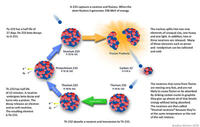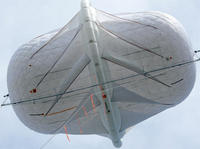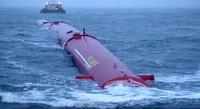-
Thorium to play limited role in U.K. future power supply

Worldwide, there has for a long time been a sustained interest in the thorium fuel cycle and presently there are several major research initiatives which are either focused specifically on the thorium fuel cycle or on systems which use thorium as the fertile seed instead of U-238; the U.K. National Nuclear Laboratory examined the topic and concluded that thorium has theoretical advantages but that these benefits are often overstated; as a result, thorium fuel cycle at best has only limited relevance to the United Kingdom as a possible alternative plutonium disposition strategy and as a possible strategic option
-
-
Regional, global food security effects of climate change to felt soon
Research shows that within the next ten years large parts of Asia can expect increased risk of more severe droughts, which will impact regional and possibly even global food security; on average, across Asia, droughts lasting longer than three months will be more than twice as severe in terms of their soil moisture deficit compared to the 1990-2005 period; China, Pakistan, and Turkey as the most seriously affected major producers of wheat and maize
-
-
Security education is becoming a central part of security hiring, promotion
There is a growing emphasis on homeland security-related education in security hiring in both the private and government sectors; this growing demand has lead to a rapid growth in college and university degree programs in homeland security – the number of such programs is now estimated to be 350; trouble is, those programs do not have a commonly agreed upon curriculum, and as a result, the classes chosen to be part of an individual’s curriculum are based on the available faculty, rather than proven value to the students
-
-
GovSec West Conference & Expo, Dallas, Texas, 8-10 October
The 2nd Annual GovSec West Conference & Expo in Dallas, Texas, will be held 8-10 October; the event takes a comprehensive approach to security by providing security professionals with the tools, techniques, and strategies for critical infrastructure protection, border and physical security, preparing for and responding to disasters, preventing domestic and international terrorism, and protecting against cybercrime and cyberterrorism
-
-
Rinderpest: how the world’s deadliest cattle plague was eradicated
Rinderpest, the deadliest of cattle diseases, was declared vanquished in May 2011; after smallpox, it is only the second disease (and first livestock disease) ever to be eradicated from the earth; the insights gained from the eradication campaign may be applied to similar diseases that today ravage the livestock populations on which the livelihoods of one billion of the world’s poor depend; the lessons could also be applied to “zoonotic” diseases which are responsible for 2.4 billion cases of human illness and 2.2 million deaths per year
-
-
At least 200,000 tons of oil, gas from Deepwater Horizon spill consumed by bacteria

Researchers have found that, over a period of five months following the disastrous 2010 Deepwater Horizon explosion and oil spill, naturally occurring bacteria which exist in the Gulf of Mexico consumed and removed at least 200,000 tons of oil and natural gas that spewed into the deep Gulf from the ruptured well head
-
-
The spring 2010 BP oil disaster could have been prevented: expert
The BP oil disaster in the Gulf of Mexico during the spring of 2010 could have been prevented if the experiences of earlier disasters had been put to use, an expert claims; the U.S. government is now accusing BP of gross negligence and deliberate misconduct, and taking the company to court
-
-
Bolstering e-mail security
On the whole, security is not a primary concern for most day-to-day e-mails, but some e-mails do contain personal, proprietary, and sensitive information, documents, media, photos, videos, and sound files; the open nature of e-mail means that they can be intercepted and if not encrypted, easily read by malicious third parties
-
-
Canada funds digital technology to enhance maritime security, surveillance
New funding will allow exactEarth to improve its ability to locate more than 80,000 ships daily anywhere around the world and transmit this information quickly to its customers; this data is used within Canada and globally for a number of purposes, including enhancing maritime security and surveillance as well as search and rescue support
-
-
There is enough wind power to meet global energy demand

There is enough energy available in winds to meet all of the world’s demand; atmospheric turbines that convert steadier and faster high-altitude winds into energy could generate even more power than ground- and ocean-based units
-
-
Predicting waves’ height, force could double marine-based energy

In the search for alternative energy, scientists have focused on the sun and the wind; there is also tremendous potential in harnessing the power of the ocean’s waves, but marine energy presents specific challenges that have made it a less promising resource; one of these challenges is the fact that waves differ in terms of their size and force; forecasting wave height one second in advance optimizes energy collection
-
-
Questions raised about cost, reliability of BioWatch upgrade

One year ago, DHS said a new contract for Biowatch, a system for detecting biological attacks on the United States, would be awarded in May 2012 and would cost an estimated $3.1 billion during its initial five years of operation; now DHS has decided to postpone the plans due to concerns about cost and reliability
-
-
Government considering options for post-biolab Plum Island

The Plum Island biolab, located on an 840-acre island of the tip of Long Island, has always been shrouded in mystery owing to the sensitive nature of the biological research done in its high-security facilities; now the center is being shut down by DHS, and the government is considering several options regarding what should be done on the island and the research facility
-
-
Apple rejects app which tracks drone strikes against militants
Apple has rejected an app, developed by a New York student, which tracks U.S. drone strikes in Pakistan; Apple said the app violated rule 16.1 of its guidelines, which bans “excessively objectionable or crude content”
-
-
China replacing U.S. as the world's largest homeland security, public safety market
By 2014, China will become the world’s largest national homeland security and public safety market; China’s homeland security and public safety market reached $40 billion market in 2011, and it is set to grow to $45 billion in 2012; the trend will continue, increasing market value to $58 billion by 2015 and $105 billion by 2020
-
More headlines
The long view
Factories First: Winning the Drone War Before It Starts
Wars are won by factories before they are won on the battlefield,Martin C. Feldmann writes, noting that the United States lacks the manufacturing depth for the coming drone age. Rectifying this situation “will take far more than procurement tweaks,” Feldmann writes. “It demands a national-level, wartime-scale industrial mobilization.”
Trump Is Fast-Tracking New Coal Mines — Even When They Don’t Make Economic Sense
In Appalachian Tennessee, mines shut down and couldn’t pay their debts. Now a new one is opening under the guise of an “energy emergency.”
Smaller Nuclear Reactors Spark Renewed Interest in a Once-Shunned Energy Source
In the past two years, half the states have taken action to promote nuclear power, from creating nuclear task forces to integrating nuclear into long-term energy plans.
